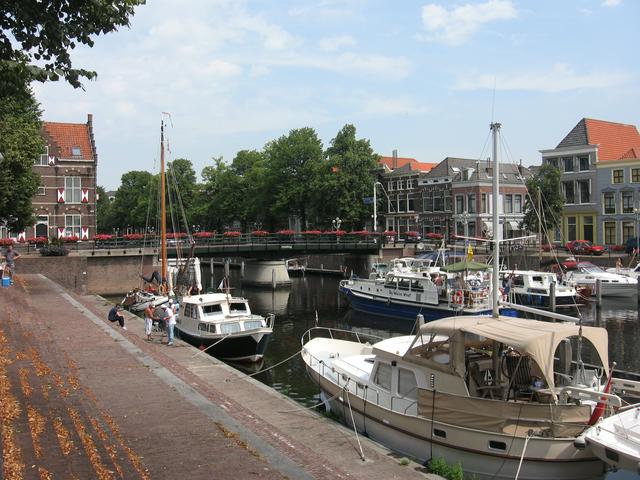 Gorinchem is a fortified town in the Groene Hart region of South Holland. The town, while small, has a historic town center with a lot of character. Some foreign visitors have already discovered this gem, but it's still missing from the average guidebook and thus very authentic. It's best to hire a bicycle and explore the surrounding countryside. Windmills, rivers and dikes, all are present in an endless flat, green polder landscape.
Gorinchem is a fortified town in the Groene Hart region of South Holland. The town, while small, has a historic town center with a lot of character. Some foreign visitors have already discovered this gem, but it's still missing from the average guidebook and thus very authentic. It's best to hire a bicycle and explore the surrounding countryside. Windmills, rivers and dikes, all are present in an endless flat, green polder landscape.
Gorinchem, spoken and occasionally written as Gorkum, is a city and municipality in Zuid-Holland, along the rivers Linge and Boven-Merwede. The city is partly within the Alblasserwaard and the Tielerwaard. The eastern part of the city, the part in the Tielerwaard, was a part of Gelderland until 1986.
The city is believed to have been settled around 1000 AD. The first reference to the then town dates from 1224. The town was purchased in 1273, and at the end of the 13th century, the town was fortified to protect against the neighbouring counties and duchies of Holland and Guelders. This time also saw the construction of the first public services, such as the Heilige-Geestkapel, Gasthuis and the Kanselarijkapel. Halfway through the fourteenth century, the city's ramparts were enforced with stone walls, which has a 7 gates and 23 towers. The city then gained its city rights in 1382. A large fire destroyed almost the entire town only 6 years later. Gorinchem became a part of the County of Holland in 1417.
Gorinchem would expand over time, with a large boom happening during the Dutch Golden Age. The town was heavily damaged as a result of French troops withdrawing from the country during the Napoleonic era. In 1815, Gorinchem was set to become a part of the Nieuwe Hollandse Waterlinie. The town's defence works were updated at this point.
The Industrial Revolution gave Gorinchem another boost, with industry improving, and travelling times to the rest of the country being significantly reduced with the introduction of the Staatsspoorlijn railway between Breda and Rotterdam. The Industrial Revolution, however, also resulted in the city's defence works being no longer sufficient and virtually unusable.
The first expansions of the city since the seventeenth century happened in the twentieth century. The bloom of the previous century had attracted a lot more citizens, which could no longer be housed in the city centre alone. Gorinchem has grown significantly since, but this did not deteriorate the city centre, which is still a lovely fortified city.
- VVV Gorinchem, Grote Markt 17, +31 183 631 525. M 12:00-17:00, Tu-F 09:30-17:00, Sa 10:00-16:00.
VVV Gorinchem, Grote Markt 17, +31 183 631 525. M 12:00-17:00, Tu-F 09:30-17:00, Sa 10:00-16:00.
- Grote Kerk. The original medieval St. Martin's church was demolished in the 19th century, but the original bell tower survived and can be visited during summer.
- Gorcums Museum. Tu-Sa 10:00-17:00, Su 11:00-17:00. The town's museum, with a display on the history of Gorinchem and the internationally known Martyrs of Gorcum.
- Lingehaven. A picturesque historic harbour of the town on the river Linge. It is now a tourist harbour.
Grote Kerk. The original medieval St. Martin's church was demolished in the 19th century, but the original bell tower survived and can be visited during summer.
Gorcums Museum. Tu-Sa 10:00-17:00, Su 11:00-17:00. The town's museum, with a display on the history of Gorinchem and the internationally known Martyrs of Gorcum.
Lingehaven. A picturesque historic harbour of the town on the river Linge. It is now a tourist harbour.
- Dit is in Bethlehem. 16th-century building with rich Renaissance facade. It hosts a bookshop.
- Dit is in Abraham's Schoot, Langendijk 72. Evangelical Lutheran Church in Gorinchem.
- De Doelen, Molenstraat 30-32.
- Burgerkinderenweeshuis.
- Heilige Geestkapel. With a remarkable Kapeltoren — chapel tower.
- Huis 't Coemtal van God.
- Tolhuis.
Dit is in Bethlehem. 16th-century building with rich Renaissance facade. It hosts a bookshop.
Dit is in Abraham's Schoot, Langendijk 72. Evangelical Lutheran Church in Gorinchem.
De Doelen, Molenstraat 30-32.
Burgerkinderenweeshuis.
Heilige Geestkapel. With a remarkable Kapeltoren — chapel tower.
Huis 't Coemtal van God.
Tolhuis.
- Dalempoort. The only survived of the 4 original city gates.
- De Hoop. Windmill.
- Nooit Volmaakt. Windmill.
- Vestingwallen.
Dalempoort. The only survived of the 4 original city gates.
De Hoop. Windmill.
Nooit Volmaakt. Windmill.
Vestingwallen.
- Galileo, Hoogstraat 25, +31 183 636-793. A good Italian restaurant that overlooks the canal that splits the fortified center in half. The pizzas are relatively large, so a good value for those on a budget. Meat and fish menus are a lot more expensive though. €13-27.
- La Caponnière, Kanselpoortweg 1. Sa Su 13:00-19:00. Wine and tasting room located at the former captioner.
Galileo, Hoogstraat 25, +31 183 636-793. A good Italian restaurant that overlooks the canal that splits the fortified center in half. The pizzas are relatively large, so a good value for those on a budget. Meat and fish menus are a lot more expensive though. €13-27.
La Caponnière, Kanselpoortweg 1. Sa Su 13:00-19:00. Wine and tasting room located at the former captioner.
- Pavlov, Langendijk 23, +31 183 630 392. Cosy bar with interesting choice in beers, small terrace and lunch.
- De Keizer, Keizerstraat 14, +31 0183 634 661. Beer pub with large range of Belgian and Dutch beers.
Pavlov, Langendijk 23, +31 183 630 392. Cosy bar with interesting choice in beers, small terrace and lunch.
De Keizer, Keizerstraat 14, +31 0183 634 661. Beer pub with large range of Belgian and Dutch beers.
